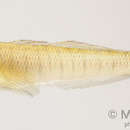Diagnostic Description
provided by Fishbase
Scales on predorsal midline 13-20, usually 15-18; scales in horizontal series 46 to 51, usually 48-49; breast scaled; belly anteriorly with small naked patch next to pelvic base (Ref. 34009).
- Recorder
- Christine Marie V. Casal
Life Cycle
provided by Fishbase
Benthic spawner.
Migration
provided by Fishbase
Amphidromous. Refers to fishes that regularly migrate between freshwater and the sea (in both directions), but not for the purpose of breeding, as in anadromous and catadromous species. Sub-division of diadromous. Migrations should be cyclical and predictable and cover more than 100 km.Characteristic elements in amphidromy are: reproduction in fresh water, passage to sea by newly hatched larvae, a period of feeding and growing at sea usually a few months long, return to fresh water of well-grown juveniles, a further period of feeding and growing in fresh water, followed by reproduction there (Ref. 82692).
Morphology
provided by Fishbase
Dorsal spines (total): 7; Dorsal soft rays (total): 10 - 11; Analspines: 1; Analsoft rays: 10 - 12
- Recorder
- Christine Marie V. Casal
Biology
provided by Fishbase
Occurs inshore (Ref. 4343) and enters brackish and fresh water along the upper tidal zone of rivers (Ref. 12693). Larvae spend time in the marine zooplankton and as juveniles, about 135 days old, recruit to freshwater streams where they undergo rapid growth and morphological changes neceassary for upstream migration to the adult habitat (Ref. 51037). Marketed fresh in mixed catches (Ref. 12693).

